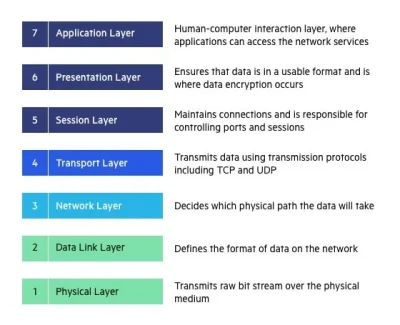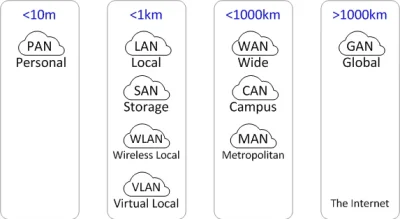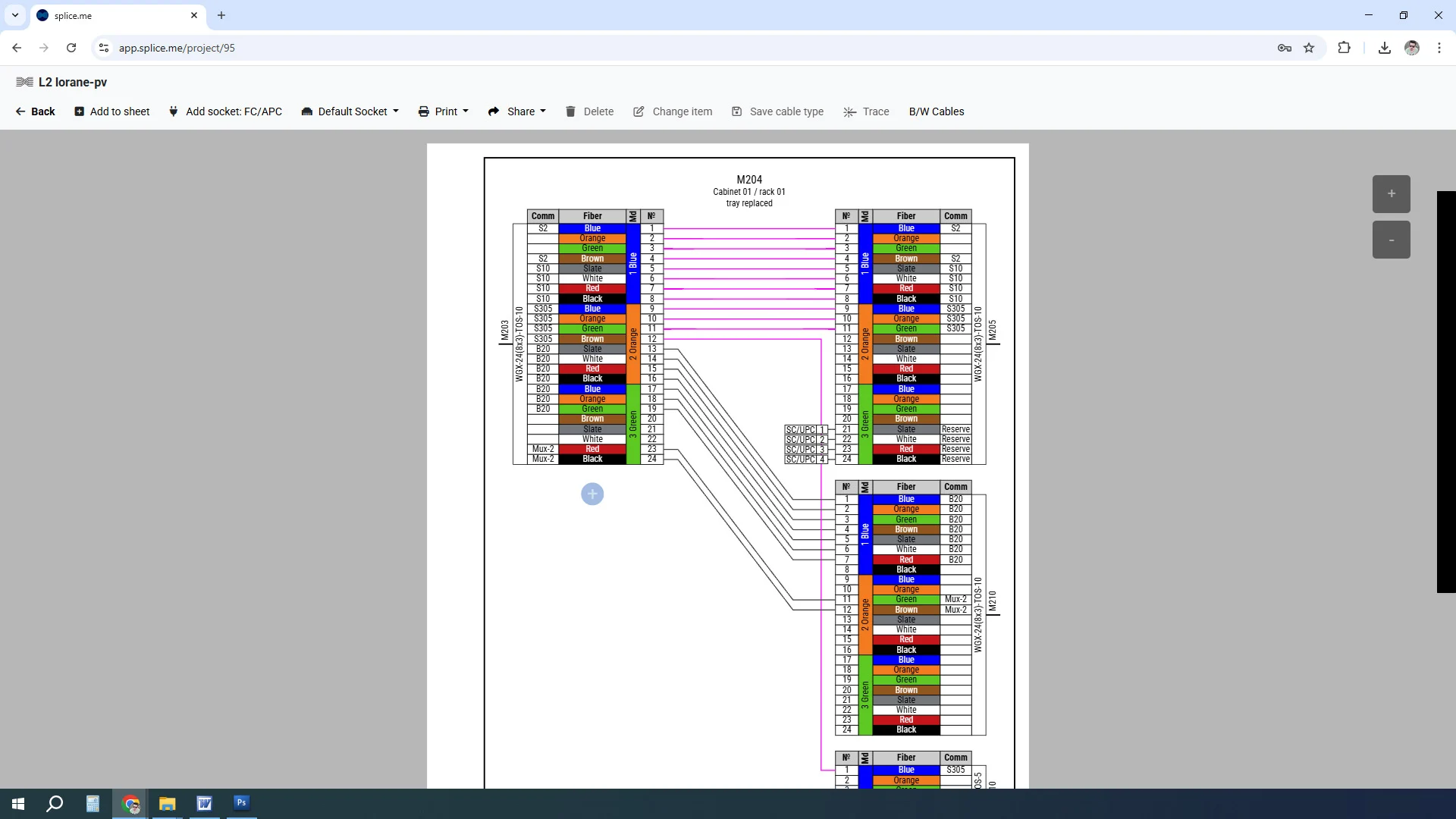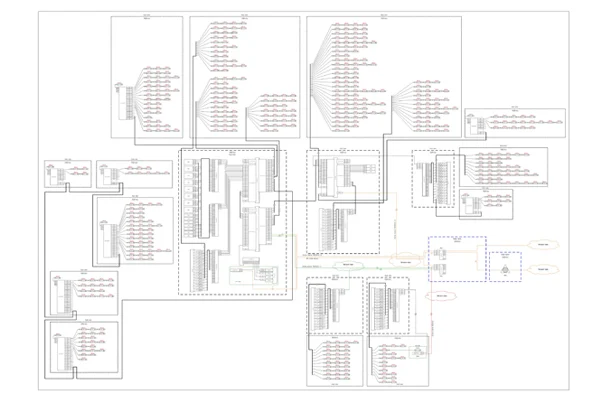When we talk about different types of networks such as LAN, WAN, MAN, PAN, or SAN, it’s important to understand that this division is not strict but very conditional, and there are no certain boundaries between these types of network. You can look at them in terms of distances they span, but they can merely overlap. In terms of transmission medium they can be fiber optic, copper, anything. And their wireless subdivision is also conditional, as various wireless technologies can be utilized, often causing misunderstanding.
So the recap is:
- different network types are not on different layers of OSI model
- different network types are not different kinds of a single layer of OSI model
In fact LAN, WAN, MAN usually emphasize different parts of this layered structure, depending on its purpose and scale.

LAN
A local area network, or LAN, is typically confined to a small geographic space like a home, office, or campus. Because it is about direct connectivity between nearby devices, the lower layers of the OSI model play the most significant role. The strength of a LAN is in providing fast, stable, and low-latency connections at the bottom layers.
In terms of OSI model LAN is about layers 5 to 7.
In terms of network switching, LAN is usually within L1 or neighboring L2 switches.

WLAN
WLAN is a LAN but wireless. It can be a Wi-Fi or Bluetooth network, or can involve FSO (free-space optics) transmission systems.
So in terms of OSI model WLAN is also about layers 5 to 7 and additionally about layer 1, which defines the transmission medium.
VLAN
A virtual local area network is a way to create multiple isolated logical networks and independent broadcast domains, on a single physical network infrastructure, like a switch or router. It allows network administrators to segment traffic, group devices into virtual groups that don’t need to be physically near each other.
In terms of OSI model VLAN is about layers 2 only.
In terms of network switching, VLAN can be a part of any layer.
PAN
PAN (personal area network) is a network for interconnecting devices around an individual’s workspace within a few meters. It can include a set of devices like your phone, headset, TV, clever home appliances, whatever, all connected to your PC or your network router. So basically it is the ‘locallest’ local area network, which is also primarily wireless.
SAN
SAN (storage area network) usually links servers and storage devices. SAN is interesting because it spans both the lower and middle layers of the OSI model. At the physical layer it may use fiber optic channel cabling, while the data link and network layers provide dedicated transport mechanisms. The transport layer also becomes important because SCSI commands may be encapsulated in protocols like iSCSI over TCP. Consider it as a LAN but for storage. Or as a LAN exclusively for a data center.
In terms of OSI model SAN is about layers 1, 2 & 5 to 7.
In terms of network switching, LAN is usually within L2.
WAN
In contrast, a wide area network, or WAN, operates over much larger distances, sometimes across entire countries. Here, the network layer of the OSI model takes center stage, because routing and addressing are essential to move data from one local network to another. While physical media such as fiber optic cables and even satellites enable the underlying transmission, it is protocols like IP and routing mechanisms such as BGP that ensure data can find its way between distant networks. The transport layer also becomes more critical in a WAN, since latency and reliability must be managed over long distances.
OSI – nearly all layers.
Network switching – L2 and L3.
MAN
Between LAN and WAN sits the metropolitan area network, or MAN, which connects devices and local networks across the scale of a city. It usually relies on technologies like Metro Ethernet and optical fiber rings, and operates across the physical, data link, and network layers. While similar to a WAN in terms of interconnection, a MAN tends to deliver higher bandwidth and lower latency, since it does not span as vast a distance. One can consider it as a city-wide bunch of LANs or as a small WAN within one city.
OSI – layers 1 through 5.
Network switching – all L1, L2 and L3.
GAN
A global area network, or GAN, is an extensive, worldwide network connecting multiple wide area networks (WANs) to enable communication, data exchange, and access to resources on a global scale. So the Internet is a prime example of a GAN. Why do we even need this term when we already have WAN? Well, it’s a residual term, and it dates back to the times of classic telephony. Earlier, before global Internet, many separate WANs started to emerge. But the only network with really global satellite coverage was the sat telephony. Which needed a separate name to separate itself from data networks. So it was called GAN to emphasize the contradiction with data WANs.
Why VPN is not a VLAN, and why EPN is not a network type?
A VLAN logically segments a single physical network into separate domains, and operates only on level 2 (data) of the OSI model. In contrast, a VPN (virtual private network) creates a secure, encrypted tunnel over a public network to connect users and devices to a private network, and is about layer 3 (network) or sometimes 4 (transport).
An EPN, or an enterprise private network is a private, secure communication network built by an organization to connect its various sites, departments, and systems, enabling secure data sharing, resource management, and business operations. So in fact it is a LAN inside a building, or various LANs connected by VLANs and VPNs. But it is not a WAN.
WLAN and POLAN are not a thing (not a network type)
WLAN is a LAN, POLAN is a passive optical (meaning fiber) LAN. So they are the same LANs but with regard to layer 1 of the model (medium). No other peculiarities.
SAN as system-area network
Unlike storage area networks, system area networks focus on high-bandwidth communication for processor-to-processor and server-to-server interactions within a single system. Their only peculiarity is their own special cables, patch-cords and connectors, which reside in layer 7.
Types of networks in terms of fiber
In terms of fiber optic network design, all the variety of network types are all the same. They all consist of cables and nodes where fibers are spliced together. A fiber splice chart for connecting fibers should be treated the same way for LAN, MAN and WAN of any size.
Conclusion
When viewed together, these network types illustrate how the OSI model serves as a universal framework. A LAN emphasizes the lower layers, a WAN highlights the network and transport layers, a MAN blends both, a PAN relies mostly on the physical and data link layers, and a SAN bridges the lower layers with transport. Each network is built with the same layered model in mind, but each brings its own priorities depending on scale, purpose, and performance needs.
Related posts:
Dark Fiber in fiber optic networks design
The Guide to OSP Fiber Networks: Design, Planning, Management
Understanding the fiber optic network diagram and its relation with splice diagram
Take care of your splice sheets
1000+ ISPs are already saving weeks of work with Splice.me!




